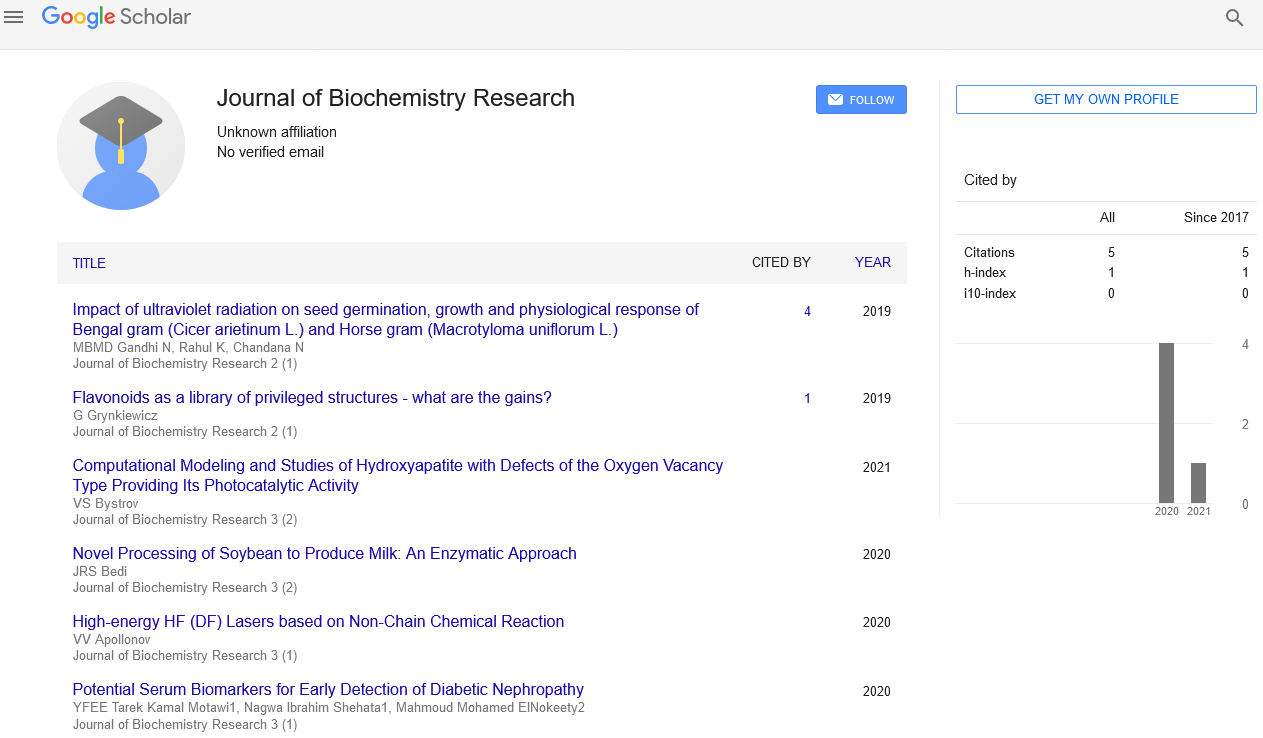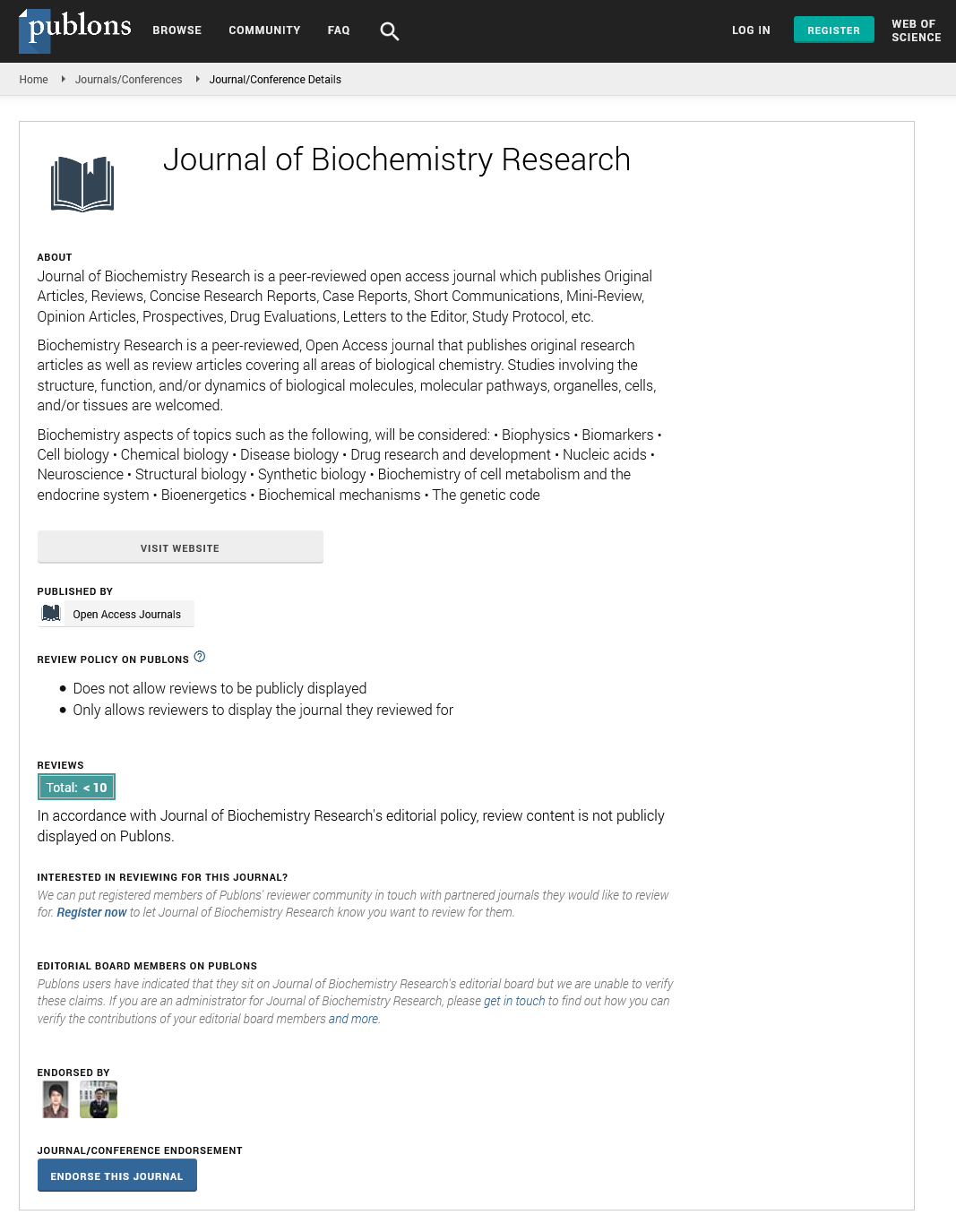Mini Review - Journal of Biochemistry Research (2023) Volume 6, Issue 2
Biochemistry: Enzyme Functions and Drug Development
Dr. Emily Gour*
Department of Biochemistry and Stem Cell and Research
Department of Biochemistry and Stem Cell and Research
E-mail: emily.g@gmail.com
Received: 03-April-2023, Manuscript No. oabr-23-96859; Editor assigned: 05-April-2023, PreQC No. oabr-23- 96859; Reviewed: 19-April-2023, QC No. oabr-23-96859; Revised: 21-April-2023, Manuscript No. oabr-23-96859 (R); Published: 28-April-2023; DOI: 10.37532/ oabr.2023.6(2).32-34
Abstract
Enzymes are essential biological molecules that catalyze biochemical reactions, playing a critical role in cellular processes such as metabolism, signal transduction, and DNA replication. Their function relies on their ability to selectively bind to specific substrates and catalyze chemical reactions, leading to the formation of product molecules. Understanding the molecular mechanisms of enzyme function has been of great importance in the development of drugs to treat various diseases. Drug development in biochemistry often involves targeting specific enzymes to inhibit their function or enhance their activity. Enzyme inhibitors can act by binding to the active site of an enzyme, preventing substrate binding and therefore preventing the catalytic reaction. Alternatively, inhibitors can bind to allosteric sites on the enzyme, causing a conformational change that alters the enzyme’s activity. These approaches have been used to develop drugs to treat a variety of diseases, including cancer, infectious diseases, and metabolic disorders. Enzyme activators are another class of drugs that have been developed to enhance the activity of specific enzymes. These molecules can bind to allosteric sites on enzymes and induce a conformational change that increases enzyme activity. Enzyme activators have been used to treat metabolic disorders such as type 2 diabetes, where they can enhance the activity of enzymes involved in glucose metabolism.
Keywords
Biological molecules • Catalyze biochemical reactions • Glucose metabolism • Signal transduction • DNA replication • Catalyze chemical reactions • Type 2 diabetes
Introduction
Enzymes are biological molecules that catalyze biochemical reactions in living organisms. These molecules play a critical role in the functioning of all living systems. Enzymes are involved in a wide range of cellular processes, including metabolism, signaling, and DNA replication. Due to their important role in biological systems, enzymes have become a key target in the development of drugs for various diseases [1].
Biochemistry is the study of chemical processes that occur within living organisms. One of the most fundamental and critical aspects of biochemistry is the role of enzymes in facilitating and regulating biochemical reactions. Enzymes are proteins that act as biological catalysts, speeding up reactions that would otherwise occur too slowly to sustain life. Enzymes play a vital role in all biological systems, from the simplest bacteria to the most complex multicellular organisms [2]. Understanding the function of enzymes is essential for advancing our knowledge of biochemistry, and for developing new treatments for diseases. The function of an enzyme is to catalyze a specific biochemical reaction. Each enzyme is specific to a particular substrate, or reactant, and binds to it in a specific way, forming an enzyme-substrate complex. This complex then undergoes a chemical reaction, resulting in the formation of a product and the release of the enzyme. Enzymes are able to catalyze reactions with remarkable specificity and efficiency, often increasing the rate of a reaction by a factor of millions or even billions [3].
The catalytic activity of enzymes is dependent on their three-dimensional structure, which is in turn determined by their amino acid sequence. Changes in the amino acid sequence, or mutations, can alter the structure and function of an enzyme, leading to diseases such as phenylketonuria, lactose intolerance, and sickle cell anemia. Drug development is an important area of biochemistry that focuses on developing new treatments for diseases. Many drugs work by targeting enzymes, either inhibiting or activating their activity. Inhibitors bind to the active site of an enzyme, preventing it from binding to its substrate and catalyzing the reaction [4]. This can be used to treat diseases caused by overactive enzymes, such as hypertension or cancer. Activators, on the other hand, enhance the activity of enzymes, and can be used to treat diseases caused by underactive enzymes, such as genetic disorders [5].
Enzyme function
The study of enzyme function has also led to the development of techniques for enzyme engineering, where enzymes can be modified to enhance their activity or specificity for a particular substrate. This has important applications in the production of biopharmaceuticals and in the development of new industrial processes.
Enzymes are proteins that are composed of long chains of amino acids [6]. These amino acids are arranged in a specific sequence, which determines the three-dimensional structure of the protein. This three-dimensional structure is critical to the enzyme’s function, as it allows the protein to interact with other molecules in a specific way. Enzymes are highly specific, and each enzyme is designed to catalyze a particular reaction. The specificity of enzymes arises from the shape of their active site. The active site is a small pocket on the surface of the enzyme where the reaction takes place. The shape of the active site is determined by the three-dimensional structure of the protein, and it is designed to fit the specific molecules involved in the reaction [7].
Enzymes are also highly efficient, and they can catalyze reactions at rates that are many orders of magnitude faster than the same reaction would occur without the enzyme. This efficiency arises from the ability of the enzyme to lower the activation energy of the reaction. The activation energy is the energy required to start the reaction, and enzymes can lower this energy by stabilizing the transition state of the reaction [8].
Enzyme inhibitors
Enzyme inhibitors are molecules that can bind to the active site of an enzyme and prevent it from catalyzing a reaction. Enzyme inhibitors can be classified as reversible or irreversible, depending on whether they bind to the enzyme in a reversible or irreversible manner. Reversible inhibitors can bind to the enzyme in a noncovalent manner, meaning that the inhibitor molecule can bind and dissociate from the enzyme. There are several types of reversible inhibitors, including competitive inhibitors, non-competitive inhibitors, and uncompetitive inhibitors. Competitive inhibitors bind to the active site of the enzyme and compete with the substrate for binding. This type of inhibition can be overcome by increasing the concentration of the substrate, as the substrate can outcompete the inhibitor for binding to the enzyme [9]. Non-competitive inhibitors bind to a site on the enzyme that is distinct from the active site. This type of inhibition cannot be overcome by increasing the substrate concentration, as the inhibitor does not compete with the substrate for binding to the enzyme.
Uncompetitive inhibitors bind to the enzymesubstrate complex, preventing the enzyme from releasing the product. This type of inhibition is rare and is not commonly used in drug development. Irreversible inhibitors bind to the enzyme in a covalent manner, meaning that the inhibitor molecule becomes permanently attached to the enzyme. This type of inhibition is irreversible and cannot be overcome by increasing the substrate concentration. Irreversible inhibitors are often used as drugs, as they can provide long-lasting inhibition of the enzyme.
Enzyme Inhibitors in drug development
Enzyme inhibitors have become a key target in the development of drugs for various diseases. By inhibiting the activity of an enzyme that is involved in a disease process, it may be possible to slow or halt the progression of the disease. One example of an enzyme inhibitor that is used in drug development is statins. Statins are drugs that are used to lower cholesterol levels in patients with high cholesterol. Statins work by inhibiting the enzyme HMG-CoA reductase, which is involved in the synthesis of cholesterol in the liver [10]. By inhibiting this enzyme, statins can reduce the amount of cholesterol that is produced in the liver, leading to lower cholesterol levels in the blood.
Conclusion
Enzymes are essential biological molecules that play a critical role in regulating biochemical reactions. Understanding the function of enzymes is crucial for advancing our knowledge of biochemistry, and for developing new treatments for diseases. Drug development is an important application of biochemistry that focuses on targeting enzymes to treat diseases.
Enzymes play a critical role in biological processes and are an important target for drug development. The use of enzyme inhibitors and enzyme replacement therapy has already led to the development of new treatments for a variety of diseases, and the study of enzyme function continues to provide insights into new therapeutic targets. However, challenges remain in the development of effective enzymebased treatments, and ongoing research in biochemistry is essential for addressing these challenges and unlocking the full potential of enzymes in medicine.
References
- Vukasinovic.Real Life impact of anesthesia strategy for mechanical thrombectomy on the delay, recanalization and outcome in acute ischemic stroke patients. J Neuroradiol. 95, 391-392 (2019).
- Salinet ASM. Do acute stroke patients develop hypocapnia? A systematic review and meta-analysis. J Neurol Sci. 15, 1005-1010 (2019).
- Jellish WS. General Anesthesia versus conscious sedation for the endovascular treatment of acute ischemic stroke. J Stroke Cerebrovasc Dis. 25, 338-341 (2015).
- Südfeld S.Post-induction hypotension and early intraoperative hypotension associated with general anaesthesia. Br J Anaesth. 81, 525-530 (2017).
- Headey DD, Chiu A, Kadiyala S. Agriculture's role in the Indian enigma: help or hindrance to the crisis of undernutrition? Food security. 4, 87-102 (2012).
- Maglaveras N, Stamkopoulos T, Diamantaras K et al. ECG pattern recognition and classification using non-linear transformations and neural networks: a review. Int J Med Inform. 52,191–208 (1998).
- Acharya UR, Faust O, Sree V et al. Linear and nonlinear analysis of normal and CAD-affected heart rate signals. Comput Methods Programs Bio. 113, 55–68 (2014).
- Deaton A, Dreze J. Food and nutrition in India: facts and interpretations. Econ Polit Wkly. 42– 65 (2008).
- Rajkumar R, Anandakumar K, Bharathi A et al. Coronary artery disease (CAD) prediction and classification-a survey. Breast Cancer. 90, 945-955 (2006).
- Headey D. Developmental drivers of nutrional change: a cross-country analysis. World Dev. 42: 76-88 (2013).
Indexed at, Google Scholar, Crossref
Indexed at, Google Scholar, Crossref
Indexed at, Google Scholar, Crossref


